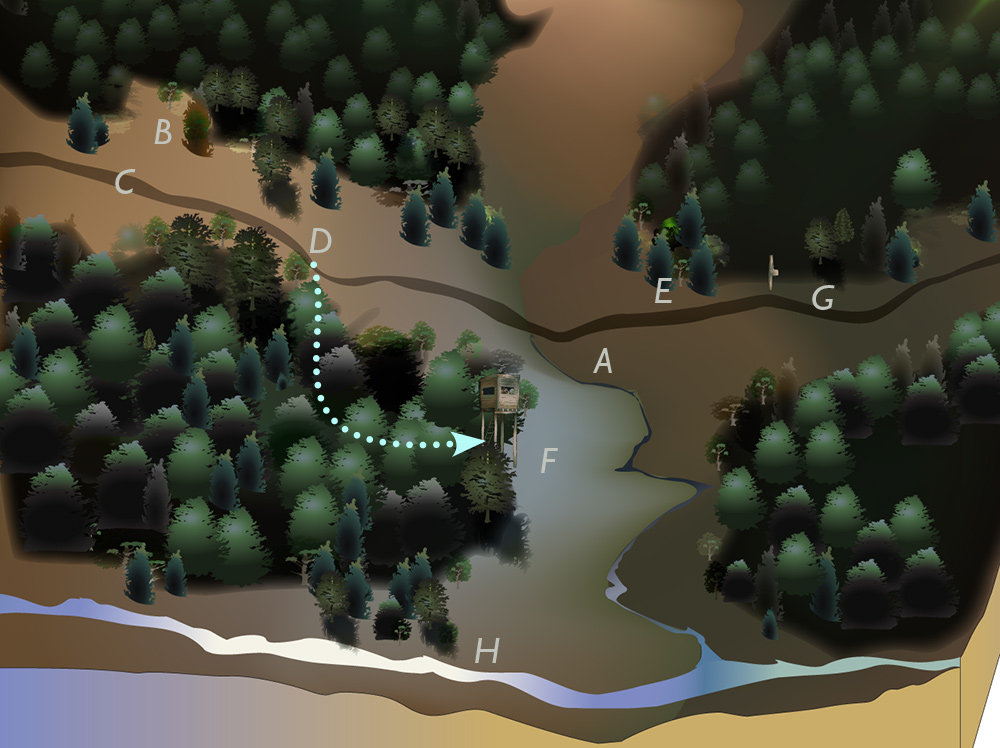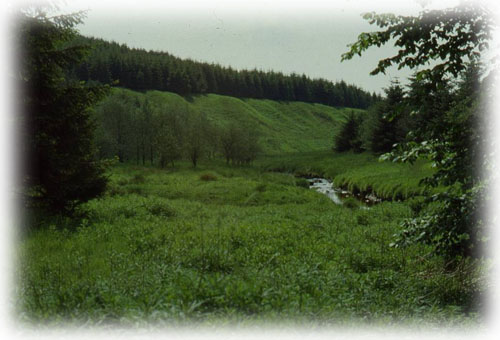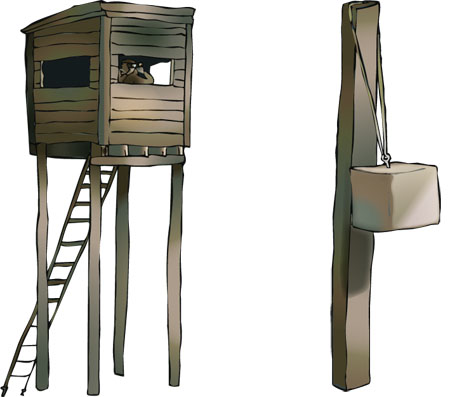
A: box junction; B: scalloped bay; C:With larger species build in suitable access for carcass retrieval; D: access path, from access road, cut through trees, to take you quietly to shooting point; E: control areas for sika need to be tighter with tree brashing of edge trees; F: shooting point chosen to look onto best soil type with consideration for wind direction and aspect; G: for larger species (ie red) salt licks may attract them to the site; H: area where trees planted down to waterside to stop wind-tunnel effect. Note that southerly facing slopes receive more direct sunlight and usually have better vegetation growth and, as a result, are popular with deer. also irregular width of rides enable deer to cross freely
Aim
The aim of this guide is to highlight design and planning considerations when incorporating deer control areas in new or restructured woodlands.1
Introduction
The ability to manage deer in woodlands is enhanced by considering deer management at all stages of forest design, and by ensuring that appropriate consideration has been given to the location of deer control areas or deer glades. The planning process should not allow the presence of deer to dictate the species and the design of the area to be planted.
Selection of Deer control areas

typical example of good design
Control areas may utilise the open space component of the woodland provided they are situated correctly. Planning the use of the open space component should be discussed with deer controllers.
Junctions where rides join can often easily be extended to make glades known as ‘box junctions’ (see illustration). When identifying and selecting the most appropriate areas of woodland for managing deer take into account the following.
- Public safety: Shooting safety is of paramount concern, especially with increased recreational use of woodlands and new woodlands close to urban areas. Ensure all deer control areas have a safe backdrop and try to locate them away from popular public areas or routes.
- Local knowledge: Involve resident deer stalkers and rangers closely in all aspects of design.
- Soil type: Give primary importance to underlying soil type, with preference to surface water gleys and brown earths.
- Aspect: Southerly facing slopes receive more direct sunlight and usually have better vegetation growth and, as a result, are popular with deer. Deer glades and lawns with other aspects are likely to have less appeal to deer unless they provide other benefits, such as shelter from prevailing wind.
- Prevailing wind: Deer will avoid draughty situations. Where possible, leave the commercial conifer crop untouched at the appropriate place, to give shelter from the prevailing wind. Sitka spruce offers the best potential for providing shelter since it is not browsed so readily as other commercial conifers, and will maintain ground shelter throughout the whole rotation.
- Minimising Disturbance: Avoid locating control areas in sites subject to disturbance by the public.
Design of Deer control areas
Once the control area has been selected, the following design steps should be considered:
- 1. Select a shooting position. The following should be taken into account:
• Topography: use a position that provides the best view of the control area, ideally on the ground, (photo of portable doe box) although high seats may be used if necessary*;
• Direction of the prevailing wind and rising/ setting sun;
• Access from the forest roads/ ride network - 2. Create shooting alleys and sighting rides.
• These should created throughout the control area from the shooting point. These allow a to provide a sense of security so deer do not feel they are in the open. - 3. Enhance control areas to attract deer:
• Introduce as much sunlight into control areas as possible. Glades should be wide enough to allow for canopy encroachment from maturing trees does not obscure sunlight or viewing capability.
• Improve the attractiveness of riparian zones by scalloping woodland edges and reduce the wind tunnel effect by planting fingers of trees at intervals either side of watercourse
• Provide a sense of security through use of graduated edges, and ensure a degree of cover throughout.
• For the larger species (primarily red deer) sometimes salt licks will attract them to the site.
• Enhance control areas for sika by tree brashing of edge trees as opposed to opening out too much.
• Consider planting sacrificial species such as willow on compartment boundaries as means to reducing fraying damage to crop trees
• Consider introducing palatable species to improve the deer usage of the site
• Swipe area to improve vegetation? - 4. Build in access.
• With the larger species and control areas in valleys build in suitable access for carcass retrieval.
• Ensure that access routes to the area minimises the disturbance to resident deer lying up in the surrounding forest area. - 5. Maintenance.
• A degree of upkeep and maintenance is required on a regular basis to retain the desired structure and maintain culling opportunity.
• Take advantage of opportunities provided by changes to habitat (e.g. management for black grouse, restructuring) to improve control areas/ glades.
• Be aware of restrictions in place to protect designated features.
Control areas may allow and support conservation objectives i.e.black grouse lek sites, butterfly management area.
First rotation and restructuring

hide and salt-lick are important features to consider
When creating deer glades in existing forests, consider the following:
- Explore and utilise all options to improve woodland design during all stages of forest rotations.
- Use experience gained on areas favoured by deer to inform siting /improvement of new/existing control areas
- Use indicator plant species to identify soil types that favour vegetation attractive to deer.
- Aim to spread control areas throughout the forest.
- Use planting-maps, soil-maps and aerial photographs in conjunction with local knowledge.
